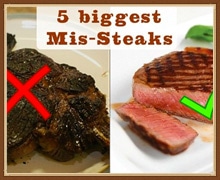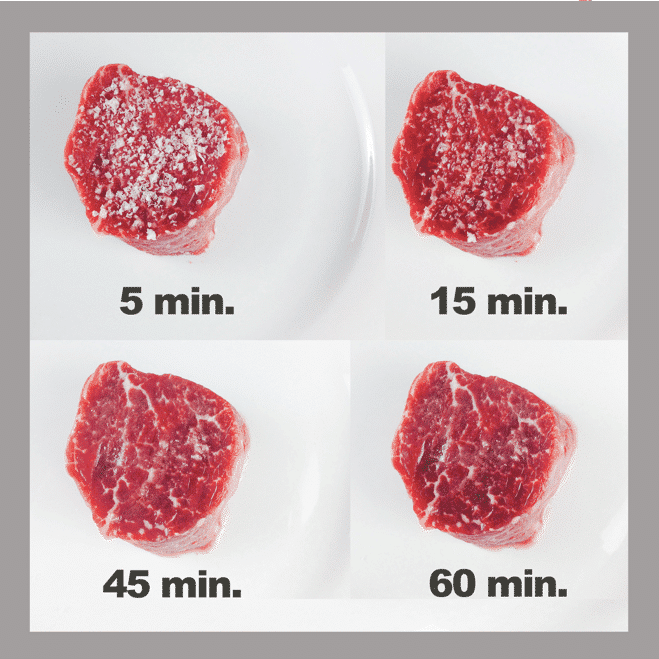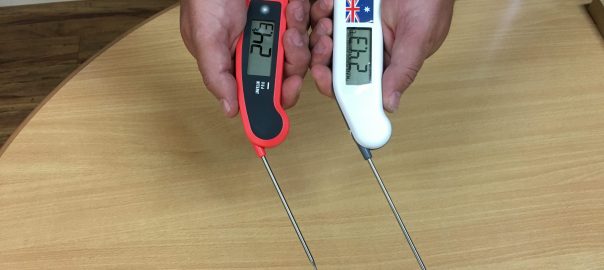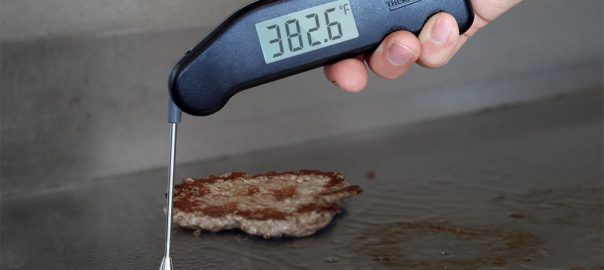
The 5 biggest Mis-Steaks people make when cooking Steak

Cooking The Perfect Steak isn’t rocket science, it’s much harder than that. Even Leonardo Di Vinci chose the easy option of designing a helicopter rather than writing a scientific treatise on perfectly cooking a piece of steak.
So, lets get these 5 most common mistakes people make out of the way.
-
Grilling With The Heat To High
It’s common practice for people to crank the grill up somewhere
approaching the surface of the sun when grilling their steaks in order to sear the outside. I recently saw an iPhone app advising users to sear their steaks at 480°C (900°F) before turning the grill down to complete the cooking. I recommend against this! In no time at all this will blacken, not brown the meat surface, smoke the oil and basically burn the meat.
We’re not aiming to nuke our steaks, we’re just aiming to grill them. Grilling is the process of applying a high, dry and direct heat either from below or above (broiling in North America) to cook food, in this case, meat. The process involves the transfer of radiant heat through the food thus cooking it. If the heat source is too high then what happens is the outer surface of the meat burns before the heat can penetrate the inner layers.
There is definitely a goldilocks zone that we need to be working within:
The ideal steak cooking temperate ranges are;
- 350°F- 430°F (180°C to 220°C)
- with 400°F (204°C ) being optional
 In order to best manage the grill surface temperature you’ve got a couple of options. You could guess or, your could pick up a Grill Surface Thermometer. This is a low cost way of managing the temperature and on of the keys in what we call the 3 Big T’s of cooking steak (Temperature, Thickness and Timing).
In order to best manage the grill surface temperature you’ve got a couple of options. You could guess or, your could pick up a Grill Surface Thermometer. This is a low cost way of managing the temperature and on of the keys in what we call the 3 Big T’s of cooking steak (Temperature, Thickness and Timing).
Note: Many BBQ’s have lids with built in thermometers. These do not measure the grill surface temp, they measure the ambient temperature. This is not relevant for grilling steaks. You need to know the GRILL SURFACE temperature, not the air temperature.
-
Incorrect Use of Oil
Meat needs to be oiled in order to grill correctly. Oil creates a layer to lubricate the meat and stop it from sticking. There are however many mistakes people use when oiling steaks, here are just a few:
- They use an out of date oil. As soon as you open a bottle of oil it begins to oxidize. In just a few weeks it can become rancid but because most oils now have been deodorized, you don’t notice. The result is a product which will taint the flavour of your food.
- They use a low smoke point oil. Olive oil has a smoke point of about 360°F. We cook at 400°F therefore, the oil exceeds its smoke point and imparts a bitter/burnt taste to the meat. Grapeseed oil is an excellent choice for high temperature grilling.
- They over-oil the meat. No-one wants to eat oily meat. Over-oiling the meat will result in the meat not heating up quickly enough and the oil still staying on the outside of meat. It’s common practice to pour a good drizzling of oil over steak which is sitting on a plate and then soak the steak in it. Do this and you’ll end up with insipid bar marks, no crust and oily steak. Best practice is to baste the oil onto the steak with a brush in a measured fashion. Then place the oiled steak onto the hot grill and let it do it’s thing.
-
Not Bringing The Meat To Room Temperature Before Cooking
 If you don’t do this you’re going to get mixed results in the doneness steaks. If steak is put on the grill with a cold heart it isn’t going to cook through evenly and the time you’d expect it to take to cook will be longer.
If you don’t do this you’re going to get mixed results in the doneness steaks. If steak is put on the grill with a cold heart it isn’t going to cook through evenly and the time you’d expect it to take to cook will be longer.
I have heard the theory of cooking steak straight out of the refrigerator because it insulates the steak from becoming over done in the middle. Personally, I don’t buy it.
It’s just another variable you’ve got to deal with. Remove your steak from the refrigerator and let it rest it until it comes to room temperature. (On a mild day this can typically take up to an hour).
This will give you a significant advantage in cooking your steaks evenly.
-
Guessing when the steaks are done
The two most common methods people use to tell when their steaks are done are;
- They guess and
- They poke, prod and even cut into it.
Neither method is satisfactory! Humans are notoriously bad at guessing so why, when there are some simple and effective tools available to help would you risk wasting a delicious piece of meat. The difference between Medium-Rare and Medium is literally just a few degrees, and it can transition from one to the next in less than 30 seconds. Here’s the tip, know the internal doneness temperate steak for the various levels of doneness (rare, medium rare, well done etc.) (you can download them here for FREE) and then, use a digital doneness thermometer to get your steak spot on the money. The Thermapen is my secret weapon in perfectly cooking steaks and I suggest you make it yours too.
-
Not resting the meat before serving
 If your aim is to serve tender juicy steaks then there’s a number of ways to go about this. You can bash the steak with a meat hammer before you cook it – not recommended, you can buy good quality steak to start with selected from the primal cut chart – definitely recommended – and, you can rest it before serving.
If your aim is to serve tender juicy steaks then there’s a number of ways to go about this. You can bash the steak with a meat hammer before you cook it – not recommended, you can buy good quality steak to start with selected from the primal cut chart – definitely recommended – and, you can rest it before serving.
Imagine that a steak is like a can of Coke and that cooking that steak is the same as vigorously shaking the coke can. Obviously, we all know what happens if we shake up a can of fizzy drink and then pop the top. It will spray everywhere. This of course is because the shaking has increased the pressure inside the can. Cooking steak on high heat is metaphorically similar to shaking a can of Coke. The heat tenses the muscle and because steak starts out at about 75% moisture this constriction is going to put those juices under pressure. Where do you think these juices go? The only place they can go; outwards! As the muscle tenses, it forces the liquid contained within toward the place of least pressure which is the surface. As the meat cooks it sizzles which is the juice or moisture being forced out of the meat. On average, a steak cooked to medium-rare will lose 15% of its total weight through moisture loss.
We know that juiciness is one of the four most important factors that people use to judge their enjoyment of a steak. If just by cooking it we loose 15% moisture, we sure as heck don’t want to lose any more by cutting it opened when it’s under pressure. That’s why allowing the steak to rest before cutting allows the liquid redistribute back into it’s centre. As the protein relaxes, it tends to firm and it’s ability at a cellular level to hold its moisture increases.
A good rule of thumb is to rest the steak for half it’s cooking time. Rest it in a warm place (not under foil – more about this later) and if possible, rest it on it’s side, this minimizes the surface area for the juice to escape.
For more information on cooking Your Perfect Steak and to get your FREE GRILL Guides, visit us at
The steak cooking Source Code is now available.
Our new book, Your Perfect Steak goes into a lot more detail about how to prepare for cooking as well as all the timings and techniques we’ve developed as we test-cooked over 1000 steaks. The book is available to purchase in Hard Copy direct from us or you can go directly to Amazon.com and download it for Kindle right now.
Order here now, from Amazon.com or Kindle.
[rpt name=”7134″]
Our international website










